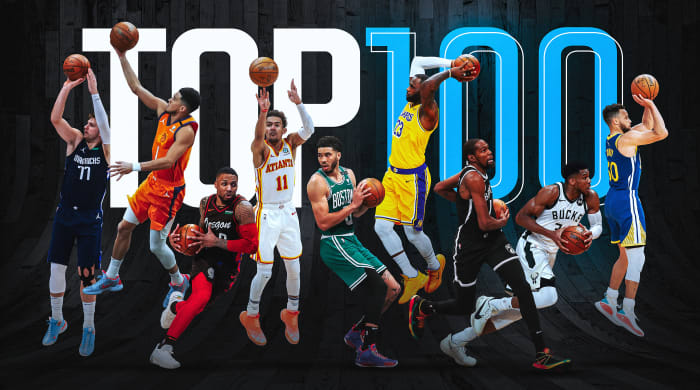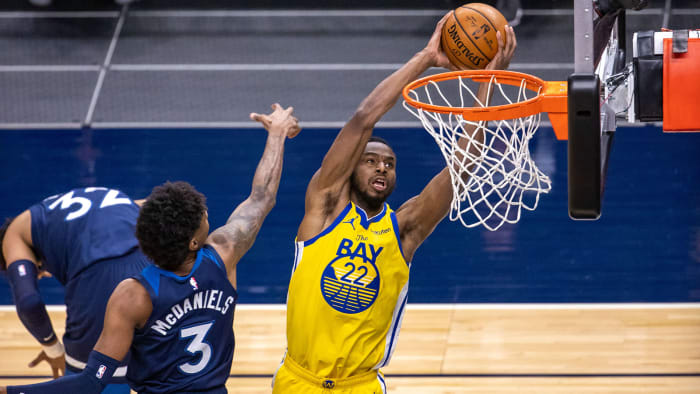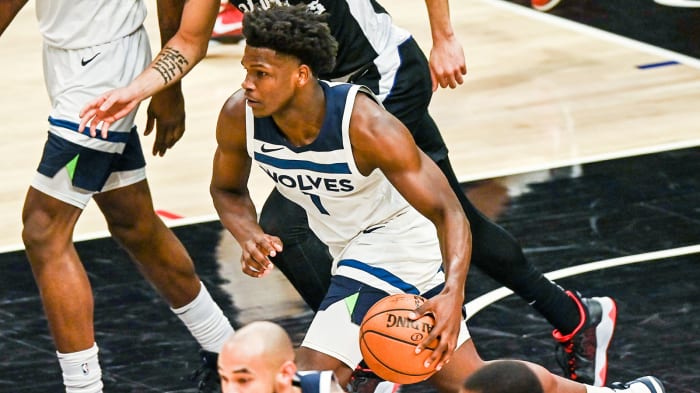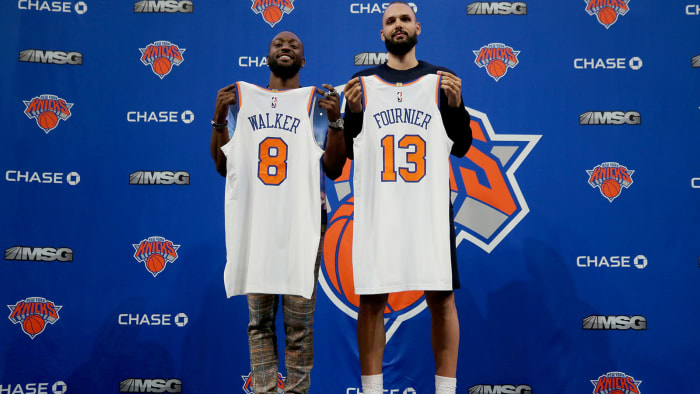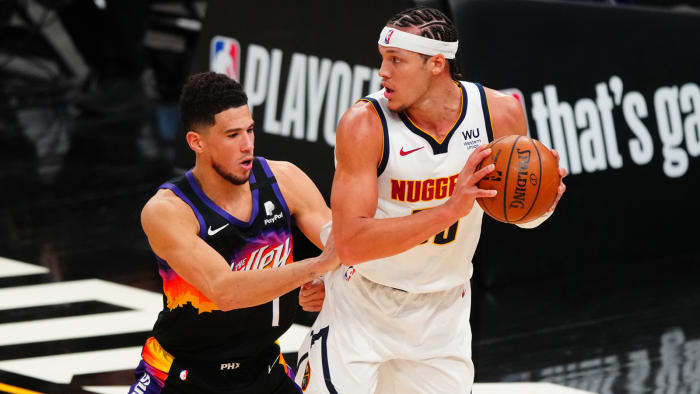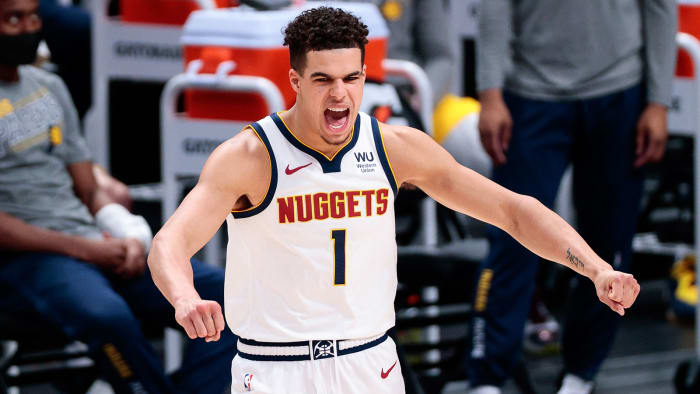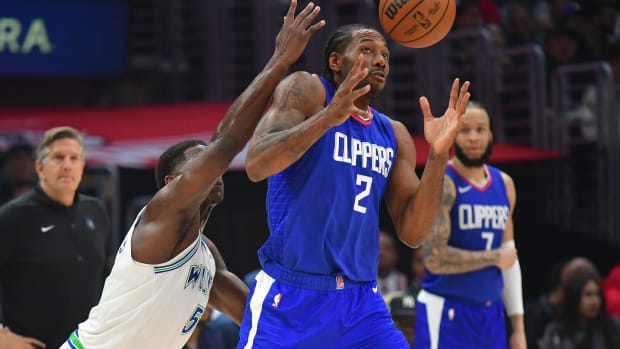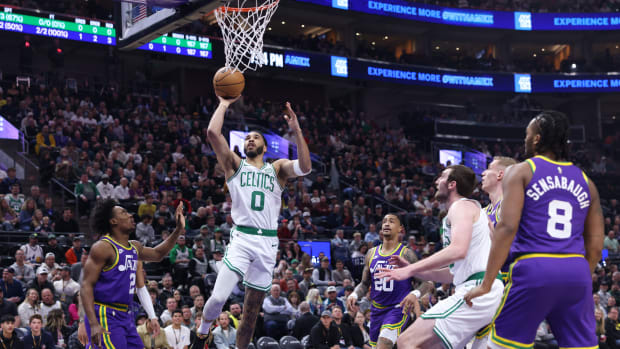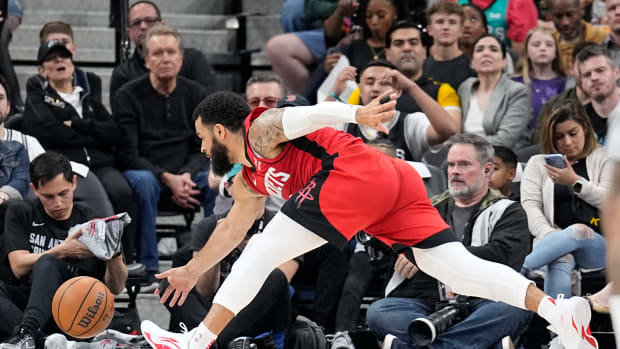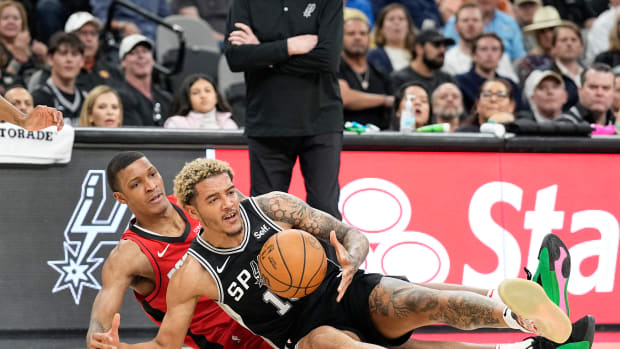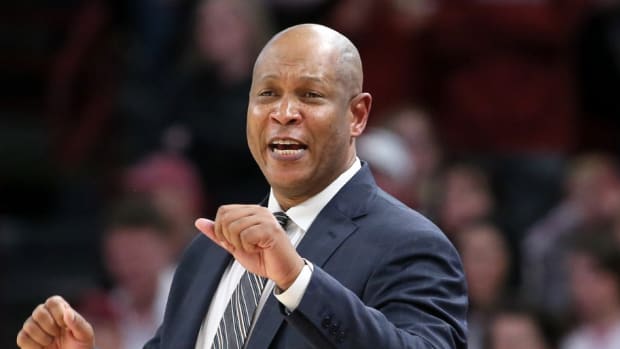Top 100 NBA Players of 2022: Let the Countdown Begin
Who will be the NBA’s best players in the 2021–22 season? Sports Illustrated‘s annual Top 100 list is back, aiming to answer that question.
This year, the rankings were determined holistically by a panel of NBA writers—Chris Herring, Rohan Nadkarni, Michael Pina and Jeremy Woo—through a combination of data and subjective evaluation. (As far as the content of those discussions is concerned, consider the first rule of Fight Club.) The goal remains to evaluate players in a vacuum as much as possible, without overvaluing team context in taking stock of their quality.
To be clear, these rankings are specifically for the upcoming season and do not take into account players’ long-term prospects or career arcs beyond 2021-22. As has been the tradition here, rookies were not considered. So it’s best to consider these rankings as short-term value projections. This is not a representation of a player’s trade value or contract value, and it does not account for the impact of his salary relative to his production. The possibility of growth or decline are factors, tied to players’ age and career stage. The list attempts to account for the entirety of a player’s impact: offense, defense, structural or otherwise, and tends to favor those with the most malleable skill-sets.
Availability due to injury and the ensuing recovery process are also factors here: this year, Kawhi Leonard, Jamal Murray and Klay Thompson were most affected in that way. The biggest snubs from this year’s list can be found here.
For further reference, explore SI.com’s Top 100 lists from 2021, 2020, 2019, 2018, 2017, 2016, 2015 and 2014. SI’s Michael Shapiro, Ben Pickman and Wilton Jackson also contributed player profiles to this year's list.
On to the top 100 ...
100. Jordan Clarkson, Utah Jazz
(Previous rank: NR)
The NBA’s reigning Sixth Man of the Year is coming off a superb year where he averaged 18.4 points while leading the league in bench scoring. Clarkson’s production as a reserve played a big role in the Jazz earning the No. 1 seed in the West last season. He will be a key to Utah's title hopes again this season. — Wilton Jackson
99. Ivica Zubac, Los Angeles Clippers
(Previous rank: NR)
Outside of a three-point shot, Zubac checks every box necessary for a modern big. On offense, he's an expert offensive rebounder and a sturdy screener with soft hands as a roll man. On defense, he's smart as a rotating big and he won’t get bullied by the game’s biggest behemoths. Zubac is perhaps the least flashy player on our Top 100 list, but don’t let that detract from his value in Los Angeles. — Michael Shapiro
98. Larry Nance Jr., Portland Trail Blazers
(Previous rank: NR)
Sturdy forwards with quick hands, springy knees, shifty feet and the understanding of how to apply those physical traits into any defensive system are highly coveted throughout the NBA. Nance Jr. succeeded on that front with the Cavaliers last season. This season, the Blazers will appreciate him as much as, or more than, his former team did. — Michael Pina
97. Tyrese Haliburton, Sacramento Kings
(Previous rank: NR)
Haliburton’s rookie season deserved far more love than it received. His shot charts are impressive, even from the tougher areas. He shot well above 40% from the two midrange parts of the floor. The next progression in his game will be to make it to the line a bit more often, something that would make Haliburton—a 40.9% three-point shooter with a 3:1 assist-to-turnover ratio—even more efficient than he already is. — Chris Herring
96. Tim Hardaway Jr., Dallas Mavericks
(Previous rank: NR)
In his third season with the Mavs, Hardaway boasted his highest field goal percentage (.447), two-point percentage (.524) and points per game (16.6) in the 2020-21 campaign. He also notched the second-highest three-point percentage of his career. The Mavs will be looking for more from Hardaway after rewarding him with a four-year, $74 million contract this offseason. — WJ
95. Jonathan Isaac, Orlando Magic
(Previous rank: NR)
A torn left ACL and meniscus in August 2020 caused Isaac to miss last season, but when available, he’s one of the league’s most disruptive defenders—able to alter shots, guard multiple positions and offer schematic versatility at 6' 11". The Magic hope a healthy Isaac will continue evolving as a scorer, with the size to shoot over defenders and skill to operate in different spots. His progress remains a key factor in Orlando’s rebuild. — Jeremy Woo
94. Malik Beasley, Minnesota Timberwolves
(Previous rank: NR)
Beasley leapt to 19.6 points per game in his fifth NBA season last year, showcasing an impressive scoring knack in Minnesota’s young core. He buried 39.9% of threes as his attempts nearly doubled compared to 2019-20, and he continues to be a dynamic athlete with a quick first step. Beasley’s explosion as a driver is critical in Minnesota. — MS
93. Derrick White, San Antonio Spurs
(Previous rank: NR)
White can do a little bit of everything and is dependable across the board, but drawing charges is the only skill he really excels at. Still, floor-raising production is always welcome, especially when it comes off a season when the subject’s three-point rate more than doubled from what it was two years ago. For now, White can make San Antonio’s rebuild less bumpy than it’d otherwise be, though his all-around trustworthy play could be even better used in a more competitive situation. — MP
92. Norman Powell, Portland Trail Blazers
(Previous rank: NR)
After developing into an integral part of Toronto's rotation, Powell was dealt to Portland mid-season last March. The 27-year-old versatile wing averaged 17 points in a career-high 34.4 minutes per game in 27 appearances with the Trail Blazers. How Portland's backcourt looks in upcoming seasons is certainly among the biggest questions in the NBA, but considering Powell inked a five-year, $90 million deal this offseason, he would figure to play a sizable role in their rotation. — BP
91. Evan Fournier, New York Knicks
(Previous rank: NR)
Fournier averaged 17.1 points on 41.3% shooting for three last season in stints with the Magic and Celtics. Despite his offensive prowess, the 28-year-old guard was hunted by the Nets on defense in the postseason. Now with the Knicks, Fournier will look to have his slashing ability mesh with Kemba Walker, R.J. Barrett, Julius Randle and Derrick Rose and help New York reach its second straight postseason for the first time since the early 2010s. — BP
90. Jae Crowder, Phoenix Suns
(Previous rank: NR)
Every NBA team needs a player like Crowder—a veteran leader and defensive anchor who handles the small hustle plays that don’t always show up in the stat sheet to help teams win. Heading into his second season with the Suns, Crowder still has a lot to offer to a young team looking to get back to the Finals. — WJ
89. Derrick Rose, New York Knicks
(Previous rank: NR)
Rose has reinvented himself as one of the league’s top reserves, providing a guiding hand and crafty scoring for a surprising Knicks team. While no longer lightning-quick, he’s one of the NBA’s top midrange scorers with his deep bag of runners and skillful finishing moves having endured. The 32-year-old Rose is also a legit catch-and-shoot threat, making a career-best 38% from three last season. Injuries scuttled his prime, but his resurgence as an elite role player has been remarkable. — JW
88. Andrew Wiggins, Golden State Warriors
(Previous rank: NR)
Wiggins will never live up to the expectations of the No. 1 pick, but he continued to grow as an effective two-way wing with Golden State in 2020-21. Last season marked the most engaged defensive season of Wiggins’s career, and he paired his defensive excellence with a solid 48% from the field and 38% from three. While he isn’t exactly a perfect fit for the Warriors’ pristine ball movement, he’s become less of a black hole in the Bay Area, too. — MS
87. Jaren Jackson Jr., Memphis Grizzlies
(Previous year rank: 64)
Jackson Jr. played in just 11 games for the Grizzlies last season after rehabbing a torn meniscus in his left knee and appeared to never get his shooting legs under him. He connected on a career-low 28.3% of his three-point looks, down from 39.4% the year before. Still, when healthy, Jackson Jr. remains one of the league’s most promising young bigs and an ideal pick-and-roll partner with Ja Morant. He’s shown flashes of star potential throughout his career, and at just 22 years old, he seems due for a breakout year sooner than later. — BP
86. Jonas Valančiūnas, New Orleans Pelicans
(Previous year rank: 97)
The Pelicans big man might be the most punishing rebound force in the NBA. He’s coming off a career year in Memphis, where he made defenses pay for sliding over to stop Ja Morant by immediately tipping home the acrobatic guard’s short-range misses. The fit next to Williamson—good or bad—will go a long way toward determining how New Orleans does this season. — CH
85. Duncan Robinson, Miami Heat
(Previous year rank: 99)
Robinson’s mark from three dipped to 40.8% last season from a 44.6% mark in 2019-20, but the undrafted forward remains a key cog in Miami’s attack. Robinson is a technician as he curls into wing triples or fades into the corner. He’s becoming increasingly crafty when crowded by defenders, creating space with a single hard dribble. Robinson is a perfect complement to Jimmy Butler and Bam Adebayo’s work inside the arc. —MS
84. Dillon Brooks, Memphis Grizzlies
(Previous rank: NR)
You’d be hard pressed to find someone who battles harder on defense than Brooks. For all the dividends that pays, though, it also has its drawbacks. Brooks logged five fouls or more a league-high 21 times last season. (The next closest guard or forward in the NBA did that just 13 times.) The next step in his progression is to have fewer wild swings from one game to the next. He’s too talented to be this inconsistent still. — CH
83. Jarrett Allen, Cleveland Cavaliers
(Previous rank: NR)
It will be interesting to see how Allen, one of the game’s premier two-way centers, fits into Cleveland’s crowded frontcourt rotation this season. But Allen will presumably play a big role for the Cavaliers, considering they doled out a five-year, $100 million deal to him this offseason. Last year, Allen averaged career-highs in points (12.8 per game) and rebounds (10 per game) after coming over from the Nets and was among the league-leaders in field goal percentage and blocks as well. — BP
82: Brook Lopez, Milwaukee Bucks
(Previous year rank: 72)
By now, Milwaukee knows precisely what to expect out of Lopez each year: 12 points, about five boards, and a block or two per game, on a three-point percentage that ranges from the low-to-mid 30s. Between that and what he does as the anchor in Milwaukee’s drop coverage, it’s the stuff of champions. So was his incredible 33-point showing versus Atlanta in Game 5 of the conference finals, without an injured Giannis. —CH
81. Seth Curry, Philadelphia 76ers
(Previous rank: NR)
Curry is widely regarded for his three-point shooting prowess, but he also continues to assert himself as a solid playmaker for the Sixers. Last year, his 2.7 assists per game were tied for the highest mark in his career. While Ben Simmons’s future with Philadelphia has created some questions as to what the franchise’s backcourt will look like long-term, Curry would appear to be a seamless fit next to whoever else is on the court with him. — BP
80. Robert Covington, Portland Trail Blazers
(Previous year rank: 66)
Portland’s forward sports arguably the best weak-side instincts in basketball as he enters his ninth NBA season. Covington is the king of sliding over in the lane and swatting shots as a help defender, and that skill translates on the perimeter as Covington racks up steals. He’s forced at least 2.5 turnovers per game since 2016-17, including an astounding 3.8 in a short stint in Houston in 2019-20. Add in a 37.9% mark from three last year, and Covington stands as one of the league’s top 3-and-D players. —MS
79. Buddy Hield, Sacramento Kings
(Previous year rank: 84)
Hield sports one elite skill, something he’s used to punish defenses time and again in his first five NBA seasons. The Oklahoma product has canned 1,155 threes through five years, a mark passed by only Steph Curry, James Harden and Damian Lillard. Hield has never shot worse than 39.1% from three in a season. As Sacramento looks to snap a 15-year playoff drought in 2021-22, Hield’s marksmanship could swing its season. — MS
78. Terry Rozier, Charlotte Hornets
(Previous rank: NR)
Two years ago Rozier was an inefficient, cat-quick combo guard whose absolute pie-in-the-sky, best-case scenario was landing on someone’s Sixth Man of the Year ballot. He has exceeded those expectations and has a brand-new $97 million extension to show for it. If the three-point shooting continues (he’s made 39.6% of them on a very high volume in Charlotte), and he’s able to wreak as much havoc in the paint as he did last year, there won’t be 10 guards harder to corral on the perimeter than Rozier this season. — MP
77. Anthony Edwards, Minnesota Timberwolves
(Previous rank: NR)
The 2020 No. 1 pick faced a predictably steep learning curve upon arrival but proved to be a quick learner. Boasting elite-level athletic gifts, Edwards averaged 23.8 points on 56.7% true shooting after the All-Star break (up from 14.9 points and 46.6% TS). If that newfound efficiency level holds constant, Edwards will be on the fast track as one of the league’s most prolific scorers. He has work to do defensively, where his attention span and effort wax and wane, in spite of quick feet and strong hands that could eventually make him a standout. Edwards could rocket up this list as his growth continues. — JW
76. Lonzo Ball, Chicago Bulls
(Previous rank: NR)
There’s always been some dissonance between Lonzo-as-concept and the role that best suits him, as he joins his third team in five seasons. Ball has made massive strides as a jump shooter, making a career-best 37.8% of threes on more than eight attempts per game last season. While still streaky, that threat allows him to play an unorthodox combo role: He’s limited playing off the dribble, but more dangerous functioning alongside ball-dominant creators. The Bulls are gambling that Ball will help unlock their new-look roster, where he’ll support Zach LaVine and DeMar DeRozan, playing directly to his strengths. — JW
Watch NBA games online all season long with fuboTV: Start with a 7-day free trial!
75. Spencer Dinwiddie, Washington Wizards
(Previous year rank: 88)
Dinwiddie logged just three games in 2020-21, but if healthy, Bradley Beal’s new co-star could mount a sneaky All-Star campaign this season. Dinwiddie is a mature point guard who excels at snaking around defenses in the pick-and-roll, patiently probing defenses. He can spend stretches with a touch of tunnel vision as a ball-handler, eschewing outside options as he works his way into a mid-range jumper. Yet for a Washington team aching for shot creation, Dinwiddie should add a much-needed boost. — MS
74. Bojan Bogdanovic, Utah Jazz
(Previous year rank: 56)
In May of 2020, season-ending surgery on Bogdanovic’s right wrist knocked the veteran forward out for Utah’s bubble run, proving a major loss for the Jazz. Last season, Bogdanovic returned and further proved his worth, serving as both a reliable shooter and more-than-capable on-ball creator. Toward the end of the regular season when Donovan Mitchell went down with an ankle injury, Bogdanovic thrived, averaging 22.8 points over the regular season’s final 16 games. — BP
73. Dejounte Murray, San Antonio Spurs
(Previous year rank: 100)
Murray’s first full season running Gregg Popovich’s offense was a modest success, full of enough subtle steps in the right direction that make it O.K. to be cautiously optimistic about his three-point shot—which has yet to tick up quite like his long twos and free throws have. Even without ideal range on his jumper, there still aren’t very many floor generals in the entire league who impact every aspect of the game quite like Murray does. — MP
72. Joe Harris, Brooklyn Nets
(Previous year rank: 86)
One of the game’s premier long-range shooters, Harris led the NBA in three-point percentage for the second time in three seasons in 2021, converting on 47.5% of his attempts. Much of his success, though, was overshadowed by his struggles against the Bucks in the Eastern Conference semifinals, which saw him shoot just 24.2% from three in the series’ final five games. That cold streak aside, Harris is a marksman and poised for another stellar season alongside the Nets’ Big Three. — BP
71. Collin Sexton, Cleveland Cavaliers
(Previous rank: NR)
Cleveland’s point guard is one of the NBA’s most polarizing players. A peek at Sexton’s counting stats suggests a star in the making, with the Alabama product averaging 24.3 points per game last season on 37.1 percent from three. Yet Sexton shot just 40.6% on all pull-up attempts last year, a mark that dipped to 31.3% from beyond the arc. Sexton is a strong scorer with impressive athletic ability. But ultimately, Sexton’s NBA destiny may be as a quality second option rather than a true leading man. — MS
70. Myles Turner, Indiana Pacers
(Previous year rank: 60)
Turner has an argument as the game’s premier shot blocker, leading all players in 2020-21 with 3.4 blocks per game. Offensively, he’s solid both as a spacer and a roll threat. Turner averaged a career-high 4.4 threes per game last season, and he’s shot a comfortable 35.4% from beyond the arc since his second season in 2016-17. There’s a high floor to Turner’s game, a bankable nightly box score. — MS
69. Kemba Walker, New York Knicks
(Previous year rank: 31)
While Walker played in only 43 games last season and has not played in a full 82-game season since the 2018-19 campaign, the Knicks could surely use his experience on offense as well as his ability to serve as a threat from the perimeter. Walker has averaged 19 points, more than four assists and three or more made three-pointers per game in each of his last five seasons. — WJ
68. Joe Ingles, Utah Jazz
(Previous year rank: 78)
The Australian swingman produces far more than his 12.1 points and 4.7 assists per game game would suggest, serving as Utah’s secondary ball-handler, spot-up shooter and, prior to last season, resident iron man. Ingles shot a blistering 45.1 percent from three last season. He’s a nightmare for defenses off the bounce despite his underwhelming build, pinging passes to open shooters with ease off each hand.— MS
67. Harrison Barnes, Sacramento Kings
(Previous year rank: 95)
His scoring numbers are down some. And he flies far beneath the radar playing in Sacramento. But make no mistake: Barnes’s well-rounded game has only improved over the years. The 29-year-old is still a solid defender, and his effective field goal rate and true shooting percentage this past year were both career-bests. With his low usage, Barnes would help any contender, which is why his name constantly comes up in trade rumors. — CH
66. Christian Wood, Houston Rockets
(Previous rank: NR)
Wood averaged 21 points per game last season on a crisp 51.4% from the field and 37.4% from three. He is decisive and controlled off the bounce, able to dance past opposing centers who attempt to stay with him on the perimeter. Sag too far, and he can bury a triple from atop the key. Wood still isn’t an impact defender and he’ll never be confused with a facilitating forward. Yet the offensive talent is too great to ignore. — MS
65. Jusuf Nurkić, Portland Trail Blazers
(Previous year rank: 44)
The brilliant version of Nurkić we saw in the 2020 bubble wasn’t quite what the Blazers got last season, and a fractured wrist limited him to just 37 games. When fully healthy, Nurkić remains one of the better traditional centers in the league: He can physically dominate space with his heft, he’s a creative passer and dangerous screener, and he moves his feet well defensively for his size. He still doesn’t shoot threes. But at his best, he’s one of the more useful bigs around. — JW
64. Bogdan Bogdanovic, Atlanta Hawks
(Previous year rank: 76)
Bogdanovic is a swiss-army-knife piece who can fill any hole in Atlanta’s attack. He shot 45.5% from three after March 1, and he’s a crafty and physical attacker off the bounce when teams (rightfully) attempt to sprint him off the line. Bogdanovic placed a scare into the Bucks in the Eastern Conference finals, tallying 68 points in his final three games on 15-35 from three. The Hawks don’t necessarily have to be the Trae Young Show to win in the postseason. A hot stretch from his backcourt partner could very well swing a series next spring. — MS
63. Aaron Gordon, Denver Nuggets
(Previous year rank: 61)
Gordon found nirvana as a role player for the Nuggets. After his tenure with the Magic revealed his limitations as a leading man, Gordon was thriving playing off Nikola Jokić and Jamal Murray. His athleticism lends itself well to random offense and strong perimeter defense. As long as Gordon isn’t being asked to do too much, he can provide serious value to any contender in the league. — RN
62. Caris LeVert, Indiana Pacers
(Previous year rank: 62)
Even if he’s slightly miscast as a true No. 1 option, LeVert is a talented player who can reliably create on offense. LeVert’s cancer scare disrupted what was a successful season for him on the court, where he averaged over 20 points for the first time in his career. Now 27 years old, LeVert should be firmly in the prime of his career. — RN
61. D’Angelo Russell, Minnesota Timberwolves
(Previous year rank: 46)
Russell has come down a bit from the high of his 2019 All-Star season with the Nets, particularly after injuries zapped much of his effectiveness in his most recent campaign with the Wolves. Russell’s partnership with Karl-Anthony Towns is very promising, but defense and efficiency remain question marks for him moving forward. — RN
60. Marcus Smart, Boston Celtics
(Previous year rank: 68 )
Smart is often recognized as the Celtics’ heart and soul, a feisty, protean guard who shares the psychology of an outside linebacker. If the work is dirty, Smart won’t mind sticking his face in it. Now entering his prime with an outside shot that remains up and down from year to year, Smart’s physical tenacity (and relatively unnoticed playmaking chops) still endears him to teammates and coaches, even when he’s a bit too overzealous with the jumper. — MP
59. OG Anunoby, Toronto Raptors
(Previous year rank: 73)
Anunoby is more than the person who claimed to introduce Serge Ibaka to scarves. He is the dream modern-day wing. He is rangy, can defend multiple positions, and he’s a career 37.5% shooter from three. With Kyle Lowry out of Toronto, Anunoby may be asked to take on a bigger role for the Raptors this season. So far, he’s delivered whenever given the opportunity. — RN
58. Kristaps Porziņģis, Dallas Mavericks
(Previous year rank: 40)
It’s almost too easy to overreact to Porziņģis’s postseason retreat. Porziņģis still averaged nearly 20 and 10 during the regular season and has enough size, length and touch to positively impact both sides of the ball. Even if he isn’t the ideal costar Dallas thought it was getting when it acquired him, he’s still one of the NBA’s most singular talents. And at 26, there’s still plenty of time for him to make another leap. — MP
57. Klay Thompson, Golden State Warriors
(Previous rank: NR)
We know what a healthy Klay can do: Play elite defense, and rain napalm from three while barely taking a dribble. We don’t know what Klay can do after returning from two major injuries, a torn ACL suffered during the 2019 Finals, and a torn Achilles suffered during the ’20 offseason. Combine the uncertainty of his health with the uncertainty of his return date, and we’re hedging our bet on Thompson until he returns to an NBA floor. — RN
56. De’Andre Hunter, Atlanta Hawks
(Previous rank: NR)
Living up to his billing as a high-floor draft pick, the 23-year-old Hunter has rapidly emerged as a valuable supporting piece in Atlanta, capable of defending all over the perimeter and knocking down jumpers on the other end. He appeared in just 23 games last year due to a nagging knee issue, but looked like the Hawks’ second-best player preinjury, showing off vastly improved shot-creation skills. A proper, full-season jump in production could be on the table. — JW
55. Jerami Grant, Detroit Pistons
(Previous year rank: 79)
Detroit made a big bet last year by paying Grant—who’d been a solid defender and fourth option in Denver—more like a No. 1 option. The gamble paid off, with Grant nearly doubling his scoring average to 22.3 per game. His efficiency took a hit with him having to create far more offense. But top pick Cade Cunningham should make life a bit easier for him. — CH
54. John Collins, Atlanta Hawks
(Previous year rank: 59)
Collins is one of just a few big men who live above the rim, confidently drill above-the-break threes and are willing to harness their athletic gifts in the trenches, setting screens and crashing the boards. As an all-around offensive exclamation point, an All-Star berth may be in Collins’s future, particularly if the Hawks continue on the track they found late last year. — MP
53: Mikal Bridges, Phoenix Suns
(Previous rank: NR)
If Merriam-Webster had a definition of 3 and D, a picture of Bridges—perhaps the league’s best role player—would appear next to it. His never-ending arms help make him an elite wing stopper. He’s drastically improved from deep, hitting 44.1% of his tries this past season. And his 76.3% mark from the restricted area ranked tenth in NBA among those with 100 attempts. — CH
52. Michael Porter Jr, Denver Nuggets
(Previous rank: NR)
MPJ is a nitrous oxide boost to the Nuggets’ well-tuned offensive engine. He’s capable of providing scoring in spades, and has an argument to be the best bucket getter on a team with the reigning MVP and Jamal Murray. While Porter Jr.’s defense and shot selection still need to catch up with his running mates, he would likely be a 20-point per night scorer on most teams. — RN
51. LaMelo Ball, Charlotte Hornets
(Previous rank: NR)
Ball’s play cut through the noise in short order, earning Rookie of the Year honors and positioning him as the centerpiece of Charlotte’s rebuild. He shot better than expected, and his gifts as a passer are obvious. The question now is to what level Ball can rise moving forward, with efficiency and consistency not yet hallmarks of his game (though his poor late-season shooting was hampered by a wrist injury). If he can lead the Hornets into the playoffs, that should speak for itself. But at age 20, we shouldn’t necessarily expect that from him, nor should it dampen the enthusiasm around his rising star. — JW
Coming Tuesday: Players 50-31
More NBA Coverage:
- SI Top 100: Biggest Snubs
- NBA Offseason Report Cards: Eastern Conference
- NBA Offseason Report Cards: Western Conference
- NBA Power Rankings: Where Each Team Stands
- The Most Exciting Matchups to Watch Next Season
Sports Illustrated may receive compensation for some links to products and services on this website.






























